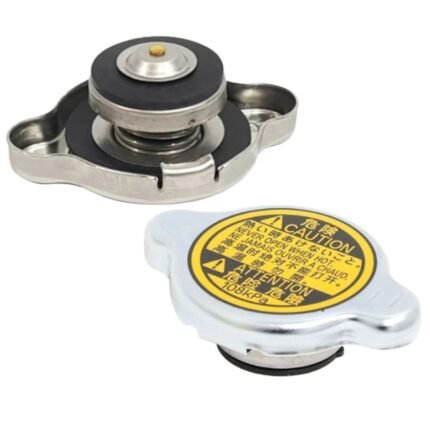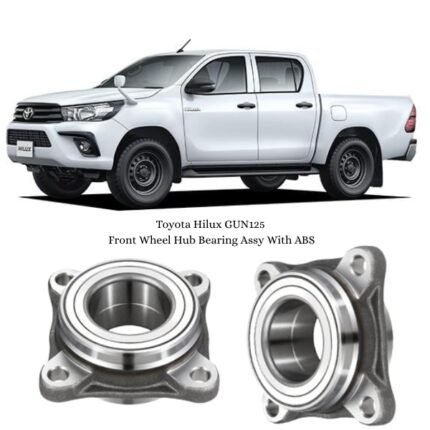Get Genuine Front Axle Hub Wheel Seal 90312-96001 in Kenya
The Front Axle Hub Wheel Seal is a crucial component in the wheel and axle assembly of a vehicle. Though small in size and often overlooked, it serves a vital purpose: protecting the wheel bearings and other internal components from contaminants while retaining lubricants within the hub. This seal ensures the smooth rotation of the wheel, extends bearing life, and prevents costly damage that can result from oil or grease leakage. In essence, the front axle hub wheel seal acts as a barrier that keeps the good in—and the bad out.
1. Function and Working Principle
The front axle hub wheel seal functions as a mechanical barrier between the rotating wheel hub and the stationary axle housing. Its primary roles include:
-
Retaining Lubrication: It keeps the grease or oil used to lubricate the wheel bearings inside the hub assembly. Proper lubrication is essential for reducing friction, minimizing heat buildup, and ensuring smooth wheel rotation.
-
Excluding Contaminants: It prevents dirt, dust, water, and other external debris from entering the wheel hub and damaging the bearings.
-
Maintaining System Pressure: In vehicles equipped with oil-lubricated hubs, the seal helps maintain the correct internal pressure balance, ensuring consistent lubrication distribution.
When the vehicle is in motion, the wheel bearings rotate at high speeds, generating heat and creating slight pressure differences. The wheel seal compensates for these changes by maintaining a tight seal around the rotating shaft while allowing the hub to move freely without frictional interference.
2. Construction and Materials
A front axle hub wheel seal is a precisely engineered component made to withstand high rotational speeds, pressure variations, and harsh environmental conditions. It typically consists of the following components:
-
Outer Metal Case: Provides structural strength and a press-fit into the hub or axle housing. It ensures the seal remains securely positioned during operation.
-
Inner Rubber or Elastomer Lip: The flexible portion that contacts the rotating surface, maintaining a tight seal while minimizing wear.
-
Garter Spring: A small circular spring that reinforces the sealing lip, maintaining consistent pressure against the shaft to prevent leaks even under vibration or thermal expansion.
-
Dust Lip (Secondary Seal): Provides additional protection by preventing dirt and moisture from reaching the main sealing lip.
-
Lubricant Retaining Surface: Designed to hold and distribute a thin film of lubricant, reducing friction between the lip and the shaft.
Materials Used:
-
Nitrile Rubber (NBR): Common for standard applications; resists oil, grease, and moderate heat.
-
Viton (FKM): Suitable for high-temperature or chemically aggressive environments.
-
Silicone Rubber: Used in extreme temperature conditions.
-
Polytetrafluoroethylene (PTFE): Offers exceptional low-friction performance and durability.
-
Carbon Steel or Stainless Steel (for casing): Provides rigidity, corrosion resistance, and structural strength.
The combination of flexible sealing materials with a rigid metal casing ensures long-lasting performance and reliable sealing under varying loads and conditions.
3. Location and Application
The front axle hub wheel seal is located between the wheel bearing assembly and the axle shaft or spindle. It is pressed into the inner bore of the hub and rides on the surface of the axle or bearing journal. Its placement ensures that the lubricating grease or oil remains confined within the bearing area while blocking contaminants from entering the system.
This component is found in a wide range of vehicles, including passenger cars, trucks, SUVs, and off-road vehicles. In heavy-duty or 4WD vehicles, the front axle hub wheel seal plays an even more critical role because the front wheels are subjected to greater exposure to dirt, water, and off-road elements.
4. Importance in the Vehicle System
A properly functioning front axle hub wheel seal contributes to:
-
Extended Wheel Bearing Life: By keeping the lubricant inside and contaminants out, it prevents premature bearing wear.
-
Improved Safety: Seized or damaged bearings caused by seal failure can lead to loss of wheel control, posing serious safety hazards.
-
Smooth Ride Quality: Proper lubrication ensures silent and vibration-free wheel rotation.
-
Reduced Maintenance Costs: Prevents frequent bearing replacements and axle repairs.
-
Protection from Corrosion: Keeps moisture and road salt from entering the hub assembly, reducing the risk of rust and pitting.
Without this small but vital seal, the integrity of the entire wheel and axle system would quickly deteriorate.
5. Performance Characteristics
High-quality front axle hub seals are engineered to deliver consistent performance under demanding conditions. Their key performance features include:
-
High Temperature Resistance: Able to endure heat generated by braking and bearing friction.
-
Superior Flexibility: The sealing lip must flex and adapt to shaft movement without losing contact.
-
Chemical Resistance: Withstands exposure to oils, greases, cleaning agents, and road chemicals.
-
Wear Resistance: Designed for long-term operation without degradation of the sealing edge.
-
Leak Prevention: Maintains tight sealing across varying speeds and temperatures.
-
Low Friction Operation: Reduces drag to improve efficiency and minimize energy loss.
These characteristics ensure that the wheel hub operates smoothly while maintaining protection against external elements.
6. Signs of a Failing Front Axle Hub Wheel Seal
Like all mechanical components, wheel seals wear out over time. Identifying early signs of failure helps prevent severe damage:
-
Grease or Oil Leaks: Visible around the inner hub or backing plate, indicating that the seal is no longer retaining lubricant.
-
Contaminated Bearings: Presence of dirt or water within the hub suggests a broken or worn seal lip.
-
Noisy Wheel Bearings: Grinding or humming noises from the wheel area may result from insufficient lubrication due to seal failure.
-
Vibration or Uneven Wheel Rotation: Damaged seals can allow bearing wear, affecting wheel balance.
-
Excessive Grease on Brake Components: A leaking seal can cause grease to contaminate brake pads and rotors, reducing braking efficiency.
Prompt replacement at the first sign of leakage is essential to prevent expensive bearing and axle damage.
7. Installation and Replacement
Proper installation is crucial for the effectiveness of the front axle hub wheel seal. Even a minor misalignment can cause premature failure.
Installation Steps:
-
Prepare the Surface: Clean the hub bore and axle shaft thoroughly, removing dirt and old seal residue.
-
Inspect Components: Check the bearing and shaft for wear or scoring that may damage the new seal.
-
Lubricate the Seal Lip: Apply a thin layer of grease to the sealing surface to reduce friction during initial operation.
-
Press the Seal Correctly: Use a seal driver tool to press the seal evenly into the bore—never hammer it directly.
-
Reassemble the Hub: Install the bearing and hub assembly, ensuring the seal lip contacts the shaft evenly.
-
Test for Leaks: After installation, run the vehicle briefly and inspect for any signs of lubricant seepage.
Improper installation—such as cocking, overdriving, or using the wrong tool—can distort the seal, leading to early failure.
8. Maintenance and Longevity
The front axle hub wheel seal typically lasts tens of thousands of kilometers but can wear faster under harsh conditions such as off-roading, frequent water exposure, or extreme temperatures. Regular inspection during wheel bearing servicing or brake maintenance is advisable.
To maximize seal life:
-
Avoid overfilling the hub with grease or oil.
-
Use manufacturer-recommended lubricants.
-
Replace seals whenever wheel bearings are serviced or replaced.
-
Inspect for corrosion on the axle surface that contacts the seal lip.
Proper care ensures the wheel seal continues to perform its protective function throughout the vehicle’s lifespan.
9. Common Causes of Seal Failure
Several factors can lead to premature seal damage:
-
Improper Installation: Misalignment or using excessive force damages the seal lip.
-
Contaminated Lubricant: Dirt and debris accelerate wear.
-
Overheating: Excessive friction or braking heat can harden or deform the seal.
-
Worn Bearing or Shaft Surface: Causes uneven contact and leaks.
-
Chemical Attack: Exposure to incompatible cleaning agents or oils can degrade rubber materials.
Understanding these causes helps prevent future seal failures and maintain consistent wheel performance.
Follow us on Facebook for more parts.





Reviews
Clear filtersThere are no reviews yet.